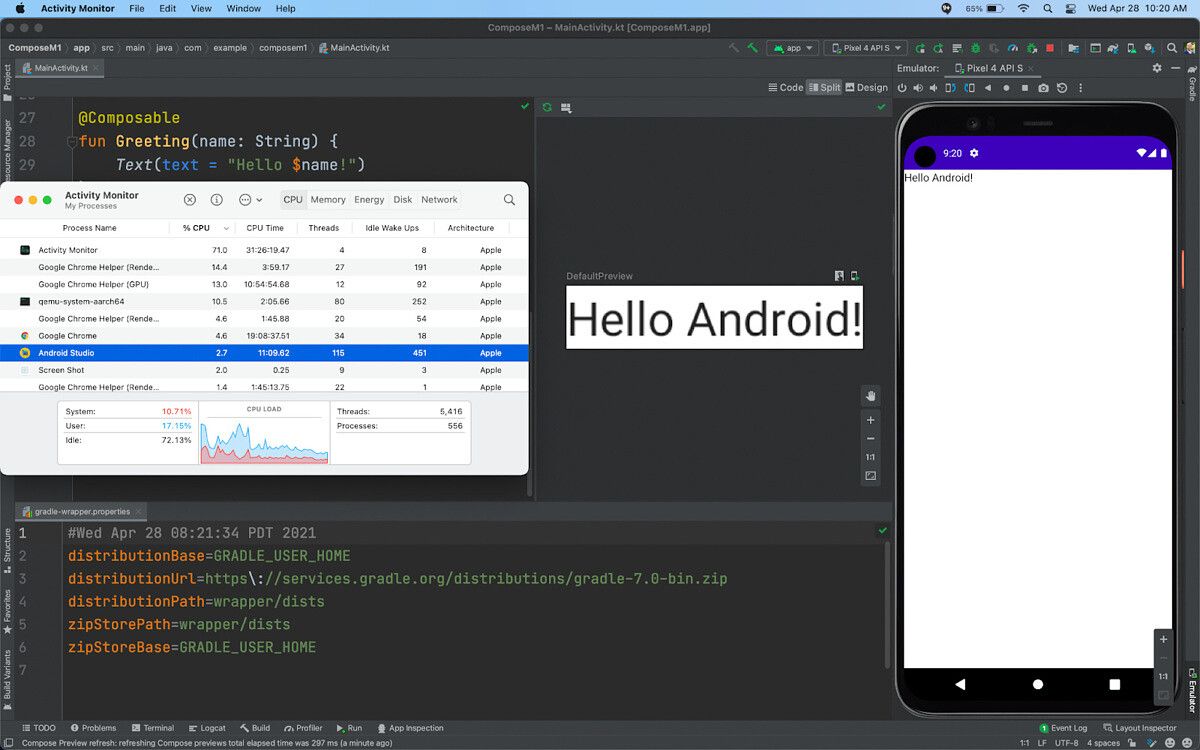
MacBook Pro 2.3GHz 8‑core Intel Core i9 VS. 3 minutes and 1 second VS. 4 minutes and 46 secinds. CPU Temperatures: 88 to 92C (+hot air blowing out 😅) VS. M1 chips are cool (in a temperature sense), but currently slow. I'll update when a Apple Silicon optimized Android Studio comes out. The latest Canary build of Android Studio (15 as of writing this) brings initial native support for M1 Macs. There are still a lot of things missing, but the basics work. You can build and run JVM. Has anyone had luck installing and running Ryujinx? It's a Switch emulator for Windows and Mac. I'm not able to install it because I'm having issues with my Homebrew(can't install gtk+3). I feel that it would run quite well on an M1 Mac considering Dolphin Wii games run perfectly. The Play Store version should already be available through Android Studio (Android R arm64 v8a Google Play). It's great that this is working via Android Studio (4.1.2) release which indeed includes Android R arm64 v8a with Google Play (Emulator version 30.3.5-7036990) - however, Chrome does not work and you can't navigate to any web pages which includes any authentication views that require.
This is the second post that I dedicate to talk about configurations using the new M1 Apple processor. As I said in the previous post, these configurations are workarounds until stable versions are released, however, for me, they have been useful and I guess that someone in the same situation as me can benefit from that.
Using Android studio in the new Macbook Air
When you install Android Studio you will get the following warning:
Unable to install Intel® HAXM
Your CPU does not support VT-x.
Unfortunately, your computer does not support hardware-accelerated virtualization.
Here are some of your options:
1 - Use a physical device for testing

2 - Develop on a Windows/OSX computer with an Intel processor that supports VT-x and NX
Mac Mini M1 16gb
3 - Develop on a Linux computer that supports VT-x or SVM
4 - Use an Android Virtual Device based on an ARM system image
(This is 10x slower than hardware-accelerated virtualization)
Creating Android virtual device
Android virtual device Pixel_3a_API_30_x86 was successfully created
And also in the Android virtual device (AVD) screen you will read the following warning:
If you want to learn more regarding virtualization in processors you can read the following Wikipedia article, the thing is that our M1 processor doesn’t support VT-x, however, we have options to run an Android Virtual Device.
Android Emulator For Apple M1
As the previous message was telling us, we have 4 options. The easiest way to proceed is to use a physical device, but what if you haven’t one available at the moment you are developing?
From now on, we will go with the option of using an Android virtual device based on an ARM system image as options 2 and 3 are not possible to execute.

Using the virtual emulator
The only thing that you have to do is to download the last available emulator for Apple silicon processors from Github https://github.com/741g/android-emulator-m1-preview/releases/tag/0.2
Once you have downloaded you have to right-click to the .dmg file and click open to skip the developer verification.
Android Studio M1
After installing the virtual emulator, we have to open it from the Applications menu.
After opening it you will see Virtual emulator in Android Studio available to deploy your Android application. Make sure to have Project tools available in Android Studio (View -> Tool Windows -> Project)
After pressing the launch button you will get your Android application running in your ARM virtual emulator :-)
Conclusion
Mac Mini M1 Android Emulator Free
In this post, we have seen that is possible to install Android Studio in Macbook Air M1 and use a virtual device even that your M1 doesn’t support VT-x. You can learn more about this emulator in the following references: